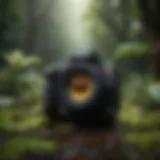Exploring the U.S. Virgin Islands: Nature's Treasures
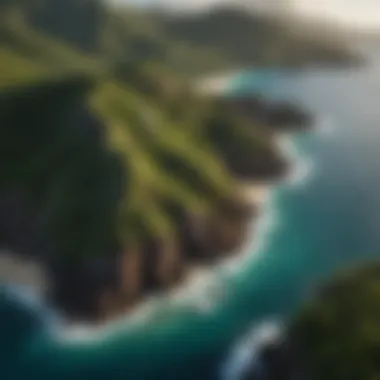

Nature Topic Overview
The U.S. Virgin Islands, located in the Caribbean Sea, are truly a gem of nature. Consisting of three main islands—Saint Thomas, Saint John, and Saint Croix—these islands boast stunning beaches, lush rainforests, and vibrant coral reefs. This region is not just a pretty face; it is also a place brimming with life. The islands' unique geography and rich biodiversity make them a natural wonder worth discovering.
These islands were shaped by volcanic activity, giving them dramatic hills and coastal cliffs. Visitors can explore everything from serene beaches to dense mangrove forests. And let’s not forget the colorful marine species swimming in the surrounding waters. This variety is not only breathtaking to behold but also essential for the ecological balance of the Caribbean.
Understanding the rich natural environment of the U.S. Virgin Islands helps foster respect and awareness about preservation efforts that are critical for the sustainability of these habitats. As we explore the wonders of these islands, we see how their natural beauty is intertwined with cultural significance, showcasing a rich history shaped by agriculture, trade, and resilience.
Fun Facts and Trivia
Here are some fascinating tidbits about the U.S. Virgin Islands that can wow young learners:
- Did you know? The islands were originally inhabited by the Taino and Carib peoples long before European explorers arrived.
- Colorful Corals: The coral reefs around the islands are home to more than 500 species of fish, many of which have bright colors and unique patterns.
- National Park: Almost two-thirds of Saint John is designated as Virgin Islands National Park, protecting its wild beauty and diverse habitats.
Images of these vibrant ecosystems are also important. You might not be able to plant your feet in the soft sand of Trunk Bay from your living room, but sharing stunning photographs can transport anyone there.
Wildlife Explorations
The U.S. Virgin Islands are teeming with fascinating wildlife waiting to be discovered. Here are some key species that inhabit these lush environments:
- Green Sea Turtles - Often spotted gliding through the warm waters, these gentle creatures play an important role in maintaining healthy sea grass beds.
- Hummingbirds - The Virgin Islands are home to species like the Antillean Crested Hummingbird, known for its incredible flying skills and vibrant plumage.
- Frigatebirds - These large birds can soar high in the sky, noticeable by their distinctive red throat pouch used in mating displays.
Wanna learn about different species? Kids can create a nature journal where they can write names and draw pictures of the various wildlife they find.
Environmental Awareness
Conservation is crucial in the beautiful U.S. Virgin Islands. The pressures of tourism and climate change threaten these unique ecosystems. Here's why it matters:
- Protecting habitats helps preserve the delicate balance of nature that supports both wildlife and human communities.
- By getting involved in clean-up initiatives or learning about conservation, kids can understand their role in maintaining these environments.
Here are some tips easy enough for kids to follow:
- Skip the Straw - Opt for reusable straws to help reduce plastic waste.
- Beach Clean-Up - Organize or join local beach-cleaning activities.
DIY Nature Activities
Do-it-yourself activities can make learning about the U.S. Virgin Islands even more exciting! Here are a few hands-on projects:
- Make a Coral Reef in a Jar: Gather sand, shells, and water to create your own miniature coral reef. Place small ocean animal figurines inside to represent the vibrant marine life.
- Nature Scavenger Hunt: Create a list of things to find, like certain leaves or rocks, and then head outside to search for them. This engages observation skills and encourages exploration of local surroundings.
By getting creative, children can apply what they've learned about nature and the ecosystems of the Virgin Islands.
The U.S. Virgin Islands show us how beautiful and important nature truly is. Each plant and animal plays a small part in the big puzzle of life, and every bit of effort to preserve this wonder counts!
Prelims to the U.S. Virgin Islands
The U.S. Virgin Islands, a stunning archipelago located in the Caribbean, hold a wealth of natural beauty and cultural heritage. This section dives into the significance of these islands, giving readers a foundational understanding of what makes them special. For families, teachers, and young learners, knowing the history, culture, and geography of the islands invites an appreciation for their unique charm. It's a treasure trove of information, much like exploring a hidden cove full of shells and wonders.
Geographical Overview
The U.S. Virgin Islands consist of three main islands: St. Thomas, St. John, and St. Croix. Each island has its own distinct features.
- St. Thomas boasts the bustling port city of Charlotte Amalie, known for its vibrant markets and historical landmarks.
- St. John is mostly national park land, preserving its natural beauty and offering picturesque trails and secluded beaches.
- St. Croix, the largest of the three, features a rich history, with sugar plantations and beautiful towns.
The waters surrounding these islands are part of the Virgin Islands National Park, which protects rich marine habitats. The clear blue waters shimmer like sapphires, beckoning snorkelers and divers alike. This geographical uniqueness not only delights visitors but also fosters diverse ecosystems, making it a hotspot for biodiversity.
History of the Islands
The history of the U.S. Virgin Islands is as colorful as the sunsets seen on their shores. Originally inhabited by the Ciboney and Carib Indians, the islands were first addressed by European explorers in the late 15th century. Christopher Columbus sailed through the area in 1493, claiming the islands for Spain.
- The islands changed hands several times, moving from Spanish to Danish control before becoming a U.S. territory in 1917.
- The Danish West India Company developed sugar plantations, which played a significant role in the islands' economy through the labor of enslaved people.
Understanding this history helps highlight the resilience of the local communities and cultural practices that continue today.
Cultural Significance
The cultural significance of the U.S. Virgin Islands is profound, blending influences from African, European, and indigenous traditions. Festivals like Carnival showcase vibrant costumes and lively music, providing a taste of local customs that continue to thrive today.
- Celebrations often involve traditional dances, local food, and community gathering.
- The islands also have a rich folklore tradition, with stories passed down through generations, reflecting the values and history of the inhabitants.
Moreover, the emphasis on community and nature in the U.S. Virgin Islands nurtures a deep respect for the environment. Understanding these cultural aspects enriches visitors’ experiences, turning a simple vacation into a meaningful journey through time and tradition.
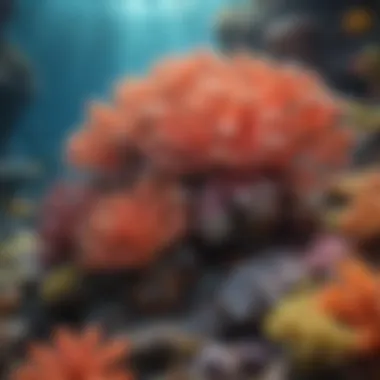

"The U.S. Virgin Islands are not just a destination; they are a living tapestry of history, culture, and natural beauty that inspires all who visit."
Geological Features
Understanding the geological features of the U.S. Virgin Islands is akin to digging deep into a treasure chest of nature's wonders. These islands boast a rich tapestry of landforms and formations that tell a story of millions of years of earth processes, shaping both the physical landscape and the ecosystems that rely on it. This section will highlight some of the crucial elements that make up the geological character of the islands, focusing on their formation, diversity of landscapes, and the special marine ecosystems that together create an intricate web of life.
The Formation of the Islands
The story of how the U.S. Virgin Islands came to be is an intriguing one. They emerged primarily from volcanic activity, along with the uplifting of coral reefs over thousands of years. You can imagine a complex dance, where tectonic plates shifted and rotated, allowing magma to burst through the surface. Most of the islands are hilly and mountainous, which gives them their dramatic landscapes.
The era of formation was not all smooth sailing. Natural events, like hurricanes and volcanic eruptions, have significantly shaped these islands. This history has left behind unique geological features such as caves, cliffs, and even marine sinkholes. Understanding this formation helps children and learners appreciate the dynamic nature of our planet and how the past influences the present.
Landscape Diversity
The U.S. Virgin Islands are not just known for their beautiful beaches; they offer a remarkable variety of landscapes that each have their own distinct characteristics. This diversity in form, structure, and ecosystem plays an integral role in maintaining the ecological balance.
Beaches and Coral Reefs
The beaches of the U.S. Virgin Islands are an essential feature, characterized by their golden sands and the preservation of coral reefs just offshore. These coral reefs are not only visually stunning but also act as habitats for numerous marine species. They are often called the 'rainforests of the sea' because they harbor a vast diversity of life.
This enchanting underwater world provides critical resources for local communities, making it a prime example of how the islands' geological features benefit both nature and people. However, coral reefs are also vulnerable to rising sea temperatures and pollutants, which is a significant challenge for conservationists. Thus, recognizing the vitality of these environments is crucial for fostering a sense of responsibility toward conservation.
Mountains and Valleys
The mountainous terrain of the U.S. Virgin Islands presents an entirely different ecological system. The steep hills and valleys create microclimates that support unique plant life and wildlife not found elsewhere. This incredible altitude variance means there's a diverse range of habitats, from dry forests on the arid slopes to lush vegetation in the valleys.
This landscape also plays a role in tourism, attracting those who enjoy hiking and exploring nature's wonders. Yet, such activities must be balanced carefully with conservation efforts to protect these habitats and the wildlife that depends on them.
Marine Ecosystems
Under the surface lies the true beauty of the islands’ geological features. The surrounding waters thrum with life, home to myriad marine ecosystems. These include not merely the coral reefs but also seagrass beds and mangroves, which provide nursery habitats for juvenile fish and other marine creatures.
Each of these marine ecosystems contributes to the overall health of the oceans, standing as critical buffers against storms and erosion. They help maintain water quality and provide food for various forms of sea life. However, as with the coral reefs, marine ecosystems face threats from pollution and climate change—highlighting the need for ongoing education and stewardship among young learners.
"The U.S. Virgin Islands are more than just a destination; they are a vital part of our global ecosystem that requires our respect and protection."
Flora of the U.S. Virgin Islands
The flora of the U.S. Virgin Islands is not just a backdrop to its breathtaking views; it holds the essence of these islands. The unique plant life here plays an essential role in maintaining the delicate balance of its ecosystems. Not only do these plants contribute to soil health and oxygen production, but they also provide critical habitats for many animal species. Understanding flora is important for appreciating the entire natural wonder that the islands present.
Native Plant Species
The U.S. Virgin Islands are home to a variety of native plant species that have adapted wonderfully to the local environment. From resilient cacti to vibrant flowers, these plants add color and life to the landscape. A few notable native plants include:
- Sisal Hemp: This tough plant is known for its long, spiky leaves and is used for making ropes and twine.
- Crimson Trumpet Vine: With its striking red flowers, this vine attracts hummingbirds and adds a pop of color to gardens.
- Bay Tree: A vital part of the island's ecosystem, its leaves are often used in local cooking.
Each one of these species provides more than just beauty. They have evolved to withstand the islands' hot sun and seasonal rains, demonstrating resilience and adaptability. Such native plants help prevent soil erosion and protect the habitat from invasive species, showcasing their crucial role in conservation efforts.
Conservation of Plant Life
Maintaining the health of plant life in the U.S. Virgin Islands is paramount. With threats from climate change and human activity, conservation efforts are more relevant than ever. Here are some strategies being adopted:
- Protected Areas: Many of the islands have established national parks and reserves to safeguard delicate ecosystems from overdevelopment.
- Native Plant Restoration: Efforts to reintroduce native species are underway, helping to restore natural habitats that have been damaged.
- Community Education: Informing the local communities about the importance of plants and how they can help is essential. Schools often engage in planting projects, instilling a sense of ownership and responsibility in the next generation.
"Conserving plant life isn't just about saving pretty flowers; it's about preserving homes for wildlife and keeping our islands healthy."
These initiatives foster a greater appreciation of the islands' flora, ensuring that the vibrant life they support continues for years to come.
In summary, the flora of the U.S. Virgin Islands is a tapestry of life that informs the very heart of its ecosystems. By understanding native species and participating in conservation efforts, we can all play a part in safeguarding the islands' natural beauty for future generations.
Fauna of the U.S. Virgin Islands
The fauna of the U.S. Virgin Islands is a vibrant tapestry woven from different threads of life, playing a vital role in the ecological balance of these tropical havens. This section dives deep into the unique animal species that call these islands home, highlighting their significance and the challenges they face in a changing world. Understanding this fauna offers insights into the health of the ecosystems and underscores the need for effective conservation practices.
Unique Animal Species
Endangered Species
Endangered species are those animals that are at risk of disappearing from our planet. In the U.S. Virgin Islands, these species are not just numbers or fancy names; they represent vital links in the ecological chain. One standout example is the Leatherback Sea Turtle, known for its size and unique leathery shell instead of a hard shell like other turtles. Its presence indicates a healthy marine environment.
These turtles often lay their eggs in the sandy beaches, but due to habitat loss and human activities, their numbers decrease. Protecting them is crucial, as they help maintain the balance of marine ecosystems, showcasing the delicate interdependence of nature.
"Every time we lose a species, we lose a history, a genetic library that might hold clues to future survival."
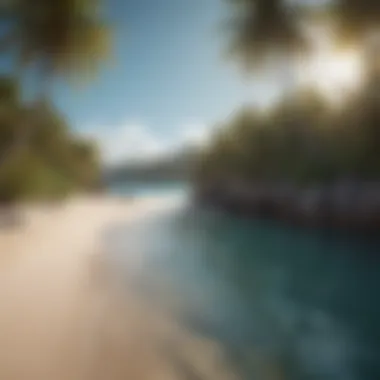

Birds of the Islands
Birds in the Virgin Islands are a real treat for any nature lover. Species like the Brown Pelican and the Magnificent Frigatebird are not only breathtaking to watch but also serve essential ecological functions. The brown pelican, for instance, is a master fisherman, diving to catch fish using its large bill.
The presence of these birds signals a thriving ecosystem, as they indicate healthy fish populations. However, like many animal species, they face threats from pollution and habitat destruction, making conservation efforts even more important. Watching these birds can inspire visitors to appreciate and protect the rich biodiversity of the islands.
Reptiles and Amphibians
The islands also host a variety of reptiles and amphibians. Notably, the Antiguan Racer is one of the world's rarest snakes. These small, harmless creatures are symbolic of the fragile balance of life found here. Their declining numbers due to invasive species pose a significant risk, reminding us of the consequences of human actions in nature.
These reptiles, alongside the islands’ colorful frogs, play a crucial role in controlling insect populations. If these animal numbers dwindle, an unchecked insect population can emerge, disrupting the delicate balance of the ecosystem. Recognizing their importance is vital for understanding how all creatures, big and small, contribute to the health of their environment.
Marine Life
Coral Reefs and Their Inhabitants
Coral reefs serve as the underwater cities of the sea, where countless creatures reside. They protect coastlines and support a plethora of marine life. The U.S. Virgin Islands boast some vibrant coral formations teeming with life. These reefs are home to various fish, crustaceans, and mollusks, forming an integral part of the marine food web.
The reefs' unique structure provides habitat for fish, helping them hide from predators while offering places for young fish to grow. However, reef degradation due to climate change, pollution, and human activity threatens their survival. Highlighting the beauty and importance of coral reefs in this article helps to foster a sense of responsibility and stewardship for these natural wonders.
Fish and Other Sea Creatures
Moving beyond the reefs, there’s a whole world to explore. The islands host a stunning variety of fish and marine life, from vibrant parrotfish to sneaky octopuses. Each plays its part in the lush marine environment. The parrotfish, with its beak-like teeth, eats algae off corals, keeping the reefs healthy and clean.
Yet, overfishing poses a significant risk to these creatures. Highlighting their myriad adaptations and their role in the ecosystem encourages readers to appreciate and conserve them. It’s a stark reminder that each fish is not just a swim in the eye but part of a greater narrative of survival and biodiversity.
Understanding and appreciating the unique fauna of the U.S. Virgin Islands is not only about recognizing the threats these species face, but it also instills a sense of wonder about the interconnectedness of life. Through effective education and conservation efforts, we can work towards safeguarding the rich wildlife that makes these islands a true natural wonder.
Environmental Challenges
The U.S. Virgin Islands (USVI) face a host of environmental challenges that significantly impact its rich ecosystems and communities. Addressing these challenges is not just about preserving natural beauty but also about safeguarding the resources and livelihoods of those who call these islands home. As the climate shifts and pressures mount, understanding these elements becomes crucial for future generations.
Climate Change Impact
Climate change is a looming threat to the U.S. Virgin Islands, manifesting in various ways. Rising sea levels are among the most concerning issues, encroaching upon coastal areas and affecting both habitats and human settlements. The islands are experiencing a change in weather patterns, with storms becoming more frequent and intense. As many people know, this leads to a range of problems such as flooding, erosion, and damage to coral reefs.
The coral reefs around the islands play a pivotal role in maintaining the marine ecosystem. They provide a protective barrier against waves and storms, but as ocean temperatures rise, these corals suffer from bleaching. This not only affects the beautiful underwater scenes but also disrupts the myriad of fish and marine species that rely on coral reefs for shelter and food.
"The health of our coral reefs directly impacts our fisheries and tourism, which are both vital to our economy here in the USVI!"
Additionally, the islands' native vegetation is not immune to the changing climate. Many plant species are struggling to adapt, and some could even face extinction. As these plants disappear, it threatens the numerous animals and insects that depend on them for food and shelter.
Threats to Biodiversity
Biodiversity is the spice of life in the U.S. Virgin Islands, with its unique and vibrant ecosystems naturally teeming with life. However, this diversity is under siege from multiple fronts. Invasive species are wreaking havoc, outcompeting native creatures and plants for resources. Feral goats and rats, for instance, have posed significant challenges for native wildlife, leading to population declines and habitat displacement.
Moreover, human activities like deforestation and urban development contribute significantly to habitat loss, disrupting the delicate balance of the islands' ecosystems. Pollution from various sources, including plastics and chemical runoff, threatens not only land-based creatures but also the ocean life around the islands.
- Invasive Species:
- Human Impact:
- Feral goats
- Rats
- Deforestation
- Urban development
- Pollution from plastics
The consequences of these threats are profound; losing even one species can lead to a cascade of negative effects throughout the food chain. Strong conservation and education efforts are essential in combating these threats, ensuring that future generations can experience the incredible biodiversity that the U.S. Virgin Islands have to offer.
Conservation Efforts
Conservation efforts are vital to safeguarding the U.S. Virgin Islands' rich natural heritage. The islands boast stunning landscapes, diverse wildlife, and unique ecosystems. However, these treasures are vulnerable to various threats, such as climate change and human activity. That's why it's crucial to implement and participate in efforts that help maintain the balance between development and biodiversity. Without these actions, future generations might not experience the beauty these islands offer.
Protected Areas
One of the cornerstones of conservation in the U.S. Virgin Islands is the establishment of protected areas. These areas are designated to preserve significant ecosystems and habitats. There are several national parks and marine reserves, including the Virgin Islands National Park on St. John and the Buck Island Reef National Monument. The rules in these areas help shield the flora and fauna from harmful activities like overfishing and pollution.
These protected spaces serve countless purposes, such as:
- Habitat Preservation: Many species, including endangered birds and marine life, find refuge here.
- Research Opportunities: Scientists can study undisturbed ecosystems to better understand how to protect them.
- Education: Visitors can learn about the islands' ecology and the importance of conservation.
Just as importantly, these areas allow for sustainable tourism. Guided tours and activities in protected regions can captivate tourists while minimizing harm, ensuring the environment remains intact.
Community Involvement
Engagement from local communities is another crucial aspect of conservation efforts. When residents participate, they often have a vested interest in the protection and preservation of their environment. Communities can lead various initiatives that promote conservation, establish sustainable practices, and educate others about the islands' natural wealth.
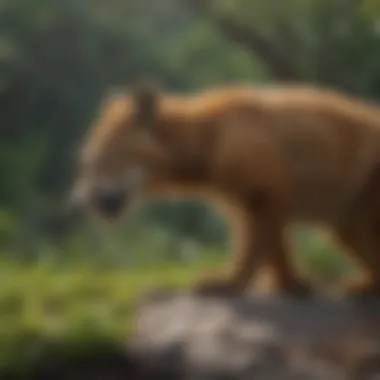

Examples of community involvement include:
- Beach Clean-Ups: Residents and volunteers often organize events to keep beaches clean and free from pollution.
- Local Workshops: Educational programs can teach skills about recycling, gardening, and biodiversity.
- Eco-Friendly Festivals: Celebrating local culture and conservation together can strengthen community ties.
Together, these efforts foster a sense of pride and responsibility among the people who call the U.S. Virgin Islands home. As they realize the value of their environment, they also inspire younger generations to carry on these practices.
"Conservation is a sometimes slow process, but every small step counts towards protecting our invaluable natural resources."
In short, the intersection of protected areas and community engagement paints a hopeful picture for the future of the U.S. Virgin Islands. By prioritizing these conservation efforts, we can ensure that the islands remain a natural wonder for years to come.
Tourism and Its Impact
Tourism plays a significant role in the social and economic fabric of the U.S. Virgin Islands. It not only brings visitors from all corners of the globe but also helps sustain the local economy. The islands' enchanting landscapes, vibrant cultures, and rich histories draw in tourists year-round, making this sector crucial for jobs and revenue. When you stroll along the sandy beaches or explore the lush rainforests, it’s important to remember that you’re witnessing the outcome of a delicate balance between nature and human activity. This balance has its perks and challenges, creating a complex relationship between tourism, development, and conservation.
"Tourism, when conducted mindfully, can be a powerful ally in the effort to protect and preserve the natural beauty of the U.S. Virgin Islands."
Eco-Tourism Initiatives
Eco-tourism is gaining traction as a way to experience the beauty of the U.S. Virgin Islands while preserving the environment. Local initiatives focus on educating tourists about sustainable practices, including waste reduction and wildlife protection. Tour operators lead guided tours that allow visitors to appreciate wildlife without disturbing their habitats.
Some remarkable eco-tourism initiatives include:
- Snorkeling and Diving: These activities are conducted in designated areas to minimize damage to coral reefs.
- Nature Walks: Guided walks through national parks provide insights into the islands' endemic species while ensuring that trails are respected.
- Local Workshops: Tourists can join workshops on recycling or sustainable agriculture, helping them engage with the community.
Visitors often leave with a deeper understanding of their impact and how they can protect these precious ecosystems.
Balancing Development and Preservation
In the face of growing tourist numbers, it’s essential to strike a balance between development and preservation. The influx of visitors can lead to increased construction, which might enhance facilities but also risks harming delicate environments. Thoughtful planning is necessary to ensure development doesn’t come at the expense of the very attributes that attract tourism.
Here are some key considerations:
- Sustainable Building Practices: Incorporating eco-friendly materials and designs can reduce the environmental footprint of new developments.
- Capacity Management: Limiting the number of visitors in sensitive areas helps preserve the natural landscapes and ensures a quality experience for all.
- Community Involvement: Engaging local residents in tourism planning fosters a shared vision of a sustainable future. Their insights and needs must be at the forefront for effective outcomes.
By addressing these challenges thoughtfully, the U.S. Virgin Islands can continue welcoming tourists while safeguarding their unique ecosystems and cultural heritage. Through education and community cooperation, tourism can be a force for good.
The Role of Education in Conservation
Education plays a crucial role in the conservation of the U.S. Virgin Islands. It serves as a bridge connecting the younger generation and the natural world they inhabit. By educating children and their families about the islands' unique ecosystems, we foster a sense of responsibility towards their preservation. Knowledge empowers the community to make informed decisions regarding environmental impacts, thus intertwining education with the future of the islands. If kids understand how their actions affect coral reefs, or why certain bird species are endangered, they are more likely to engage in practices that protect these vital resources.
"Education is not the filling of a pail, but the lighting of a fire." This quote reminds us that true education sparks curiosity and a personal commitment to conservation.
Programs for Young Learners
Several initiatives cater specifically to young learners who are eager to understand their environment. Programs in the U.S. Virgin Islands often blend fun with education, creating an engaging experience for kids aged 5-12. Some notable programs include:
- Nature Camp: A hands-on camp experience where children explore local flora and fauna, engage in crafting projects, and learn about the importance of ecosystems. It encourages outdoor play and fosters a love for nature.
- Interactive Workshops: Classes are hosted in schools or local community centers, focusing on specific topics such as marine biology, the importance of biodiversity, and ways to reduce waste. Activities are designed to be memorable and easy to relate to, such as identifying local plant species or creating art from recycled materials.
- Field Trips: Visiting national parks or marine reserves, these trips immerse learners in their local environments. Guides explain the significance of various species and habitats, providing kids a first-hand look at the beauty and complexity of their surroundings.
Such programs not only teach valuable lessons but also help shape responsible environmental stewards of the future.
Engagement with Local Communities
Involving local communities is vital for successful conservation education. When parents, teachers, and community leaders come together, the impacts are profound. Here’s why community engagement matters:
- Cultural Relevance: Local leaders can incorporate traditional knowledge and cultural practices in teaching about conservation. This invites a broader understanding of the environment and encourages respect for heritage.
- Shared Responsibility: Engaging communities builds a collective effort in protecting natural resources. When parents participate in educational workshops alongside their children, they learn and share responsibility for environmental issues collectively.
- Volunteering Opportunities: Programs that encourage families to volunteer at conservation sites often deepen connections between education and real-world action. Whether it’s planting trees or participating in clean-up days, these opportunities galvanize community support while reinforcing lessons learned in the classroom.
Building bridges between educational institutions and local communities strengthens the foundation for conservation. Through programs aimed at both young learners and families, the U.S. Virgin Islands can cultivate a generation that values and actively participates in protecting their natural wonderland.
Ending
Wrapping up our journey through the U.S. Virgin Islands, it's essential to reflect on what makes these islands not just a pretty postcard but an intricate tapestry of nature and culture. The islands' stunning landscapes, from the stretches of soft sandy beaches to the depths of vibrant coral reefs, all tell a story of evolution and resilience.
Recap of Key Insights
The exploration of the Virgin Islands reveals a wealth of knowledge. Here’s a summary of what we've uncovered:
- Geographical Diversity: Each island, with its unique shape and form, holds treasures in the hills and shores.
- Rich Biodiversity: The variety of plants and animals, many of which can't be found anywhere else, showcase how life adapts to different environments.
- Cultural Heritage: The blend of influences from various cultures creates a rich tapestry that shapes the everyday life of the islands.
- Environmental Challenges: Issues like climate change and species endangerment remind us of the urgency to act.
- Conservation Efforts: Both the local community and tourists play vital roles in protecting these precious ecosystems.
This snapshot reaffirms the islands are much more than just a vacation spot; they are vital ecosystems that demand attention and respect.
The Importance of Continued Conservation Efforts
Preserving the beauty and biodiversity of the U.S. Virgin Islands is not just a responsibility; it's a necessity for future generations. Continuous conservation efforts ensure that the delicate balance of these ecosystems remains intact. Here’s why it matters:
- Protecting Biodiversity: Every species, from the tiniest insect to the largest sea turtle, plays a role in maintaining the health of the ecosystem. Each loss is a crack in the foundation of life.
- Educational Opportunities: These islands are natural classrooms where children and adults alike can learn about ecology, geography, and our responsibility to the planet.
- Sustainable Tourism: By fostering eco-tourism, we can support local economies while minimizing our environmental footprint. This balance helps keep the islands' beauty intact for all to enjoy.
"Conservation is a state of harmony between men and land." - Aldo Leopold
In summary, as we look towards the future, the commitment to continued conservation in the U.S. Virgin Islands will not only maintain their allure but also ensure our children can experience the rich wonders of these natural paradises. By working together, locals, tourists, and global citizens can keep this natural wonder thriving.




